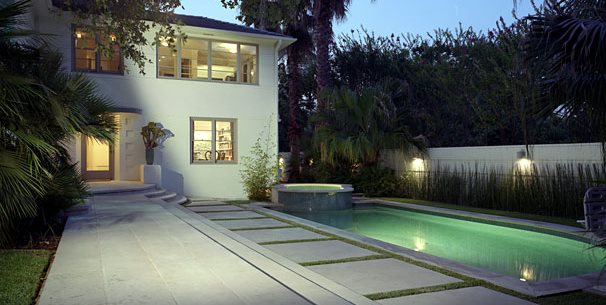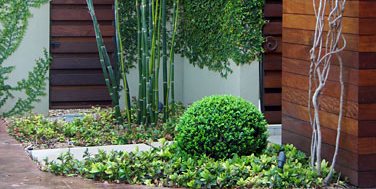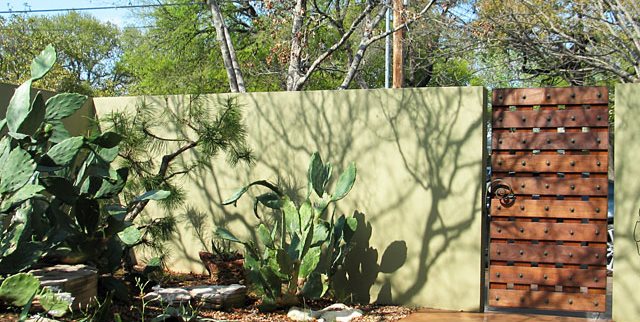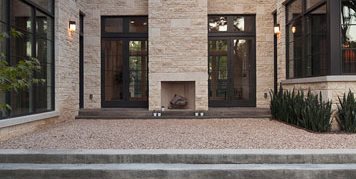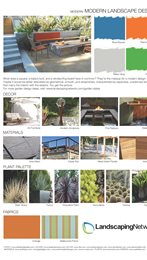Modern Landscape Design
Eight dos and don'ts from designer David WilsonUse this design sheet to help you create the perfect modern landscape. You'll get ideas for color, décor, materials, plants and fabric. It is a great starting point for any landscaping project.
Modern Landscape Style Guide (PDF)
View all Landscape Design Style Guides
Plants for a modern garden:
Trees:
Crape Myrtle (Lagerstroemia indica)
Japanese Pine (Pinus thunbergii) in pompom form
Mountain Laurel (Kalmia latifolia)
Bamboo (Phyllostachys and others)
Japanese Maple (Acer palmatum)
Agave (Agave, many)
Japanese Boxwood (Buxus microphylla)
Cast Iron Plant (Aspidistra elatior)
Berkeley Sedge (Carex divulsa)
Foxtail Fern (Asparagus densiflorus 'Meyersii')
Contemporary landscapes are known for having a clean, minimalist look with no clutter. In contrast to the naturalistic, wavy borders popular in many landscapes, this style emphasizes straight lines and geometric forms which better reflect and relate to the architecture.
David Wilson, the award-winning designer behind David Wilson Garden Design, says “One of the key ways I know my design is successful is when every element in the landscape is essential. If nothing can be removed without leaving a void, you’re left with the simple beauty of a modern design.” Here, Wilson shares his tips for designing in this style.
Dos:
- Do choose pale colors for your modern landscape. “There’s something honest and simple about a lack of strong color,” says Wilson. By using neutral, naturally-colored materials like ipe wood, limestone, weathered steel, concrete and pea gravel, you allow the sleek lines of the architecture and the landscaping to shine.
- Do choose plants with a distinct form. Japanese boxwood is a favorite because it can be clipped and manipulated into shapes, but spiky plants, soft-textured weeping plants, and anything with a strong visual punch can create the right effect when used skillfully.
- Do choose one type of plant or one color to take center stage in your design. “The minute you begin mixing plants or layering different colors in your borders, the landscape takes on a traditional design style rather than a contemporary one,” says Wilson. “Editing is key.”
- Do utilize straight lines and shapes such as rectangles and circles in your design. “I’ve always appreciated the effect of a long clean line or a beautifully-measured radius,” says Wilson. You can break up long lines of shrubbery by adding a parterre or geometrically-shaped bed at the end of them.
Don'ts:
- Don’t be lured by hot new color trends for any permanent element in the landscape. “Using a trendy color on tile or other long-lasting features is a quick route to a dated landscape,” says Wilson. “Instead, incorporate color trends by using cushions, towels, or annual flowers which can be switched out as tastes change.”
- Don’t use organic mulch in your garden beds. “The neutral color of pea gravel creates a contrast between the foliage and the ground, showcasing the minimal use of plant material,” explains Wilson.
- Don’t choose ornate furniture or decor in your modern landscape. Instead, go for a more streamlined look. Wilson recommends starting your search at Brown Jordan, an outdoor furniture retailer with a number of modern and mid-century modern pieces.
- Don’t use organic shapes in your pathways, borders or materials. Naturalistic curves do little to enhance the relationship of the landscape with the architecture. Even when choosing natural materials like stone, cut them into elongated rectangles or create a geometric pattern so they relate to the home and take on a contemporary look.
Above all, remember that when in doubt, it’s better to edit than to add new elements. While this goes contrary to our first instinct, minimalism is critical in the modern aesthetic. As Wilson points out, “If everything is a feature, nothing is a feature.”
About the designer:
David Wilson Garden Design is comprised of David Wilson and Marco Rini. While their company was founded in 1987, they’ve been designing landscapes as individuals even longer, giving them more than 60 years of experience combined. They offer a range of residential landscape design services, including coordination with architects and builders, project management, landscape design and consultation, site preparation and installation, and garden maintenance.

 Backyards
Backyards
 Front Yards
Front Yards
